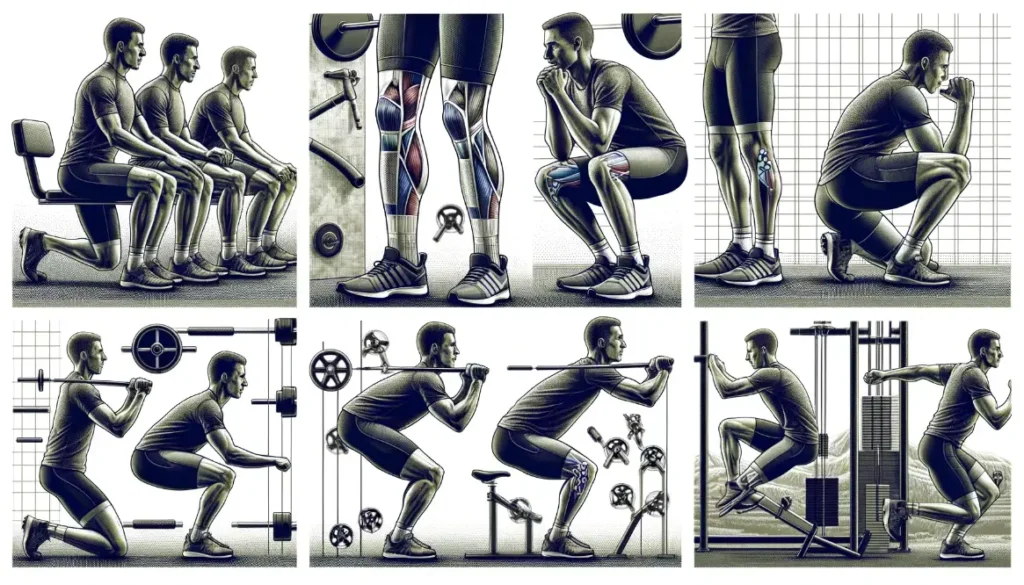
Cycling is often touted as a low-impact cardio activity that is gentle on the joints, including the knees. However, some people may experience knee pain and injuries from cycling if certain precautions are not taken. This article provides a complete guide to understanding how cycling impacts the knees, both positively and negatively. It covers the anatomy of the knees, common cycling-related knee injuries, prevention tips, warning signs, treatments, best practices, knee strengthening exercises, and frequently asked questions.
Anatomy of the Knee Joint
The knee joint is one of the largest and most complex joints of the human body. It consists of the femur (thigh bone), tibia (shin bone), patella (kneecap), and fibula (outer leg bone). These bones are connected by various ligaments, tendons, and cartilage that provide stability and cushioning.

Some key components that affect knee health during cycling include:
- Patellar tendon – connects kneecap to shin bone
- Meniscus – C-shaped cartilage that cushions and stabilizes the knee
- Collateral ligaments – provide side-to-side stability
- Cruciate ligaments – give front-to-back stability
- Articular cartilage – smooth, slippery surface that allows bones to glide over each other inside the knee joint
How Cycling Impacts the Knees
Cycling involves a repetitive pedaling motion that can impact different structures of the knee in various ways:
Pedaling Motion and Knee Joint
The pedaling motion causes the knee to flex and extend with each revolution. This forces the patella to slide up and down within the groove in the femur, putting pressure on the patellar tendon and cartilage behind the kneecap.
Impact on Ligaments and Cartilage
Cycling does not subject the ACL and other knee ligaments to high impact. However, overuse can inflame the synovial membrane lining the joint. Meniscal tears are also rare in cycling but can happen.
Effect on Muscles Surrounding the Knee
Cycling strengthens the quadriceps above the knee but can cause muscle imbalances if the hamstrings and hips are relatively weaker. The IT band on the outer thigh also bears repetitive friction that can cause tenderness.
Benefits of Cycling for Knee Health
While cycling does involve some degree of knee stress, it offers several benefits when done correctly:
Strengthens Muscles
Cycling gently works all the major muscle groups around the knee, strengthening them to provide better joint stability.
Improves Flexibility
The pedaling motion takes the knee joint through a full range of motion, maintaining flexibility of the joint and associated muscles.
Weight Loss
Cycling is an efficient fat burning exercise. Losing excess body weight reduces pressure on the knee joints while cycling or during daily activities.
Low-Impact Exercise
Cycling is considered a non-weight bearing activity unlike running. This makes it suitable for people with arthritis, past knee injuries or those at risk of developing knee problems due to excess weight.
Risk Factors That Can Aggravate Knee Problems

While cycling has definite advantages for overall knee health, certain factors can make some people more vulnerable to overuse injuries or other issues:
Improper Bike Fit
A poorly adjusted bike alters biomechanics and causes incorrect knee alignment while pedaling. This uneven distribution of force can damage cartilage and soft tissues over time.
Overuse
Ramping up cycling mileage or intensity too quickly does not provide adequate rest for tissues to recover, leading to repetitive strain injuries.
Prior Knee Injuries
Old ACL ruptures, meniscal tears, cartilage problems, etc. increase susceptibility to knee pain from cycling. Past injuries often cause muscle weakness and joint instability.
See also: Front Knee Pain When Cycling: Causes, Prevention, and Treatment 🦵
Underlying Conditions
Improper knee tracking from hip/pelvis issues can get aggravated by cycling. Other problems like arthritis, tendonitis, dislocations, fractures, and Osgood Schlatter’s Disease (OSD) also require care when cycling to prevent further damage.
Common Cycling-Related Knee Injuries
Some knee problems that can arise due to cycling primarily stem from overuse, poor bike fit, and muscle imbalances. These include:
Patellofemoral Pain Syndrome
Pain behind or around the kneecap due to irritated cartilage from friction of the patella sliding along the femoral groove with each pedal stroke.
See also: Can Cycling Improve or Worsen Knee Pain from Chondromalacia Patella?
Iliotibial Band Syndrome
Inflammation of the IT band on the outer knee from excessive rubbing against the distal femur, especially when pedaling out of the saddle.
Meniscal Tears
Damage to the shock absorbing cartilage between the femur and tibia due to sudden inward/outward rotation of knees or squatting pedaling motions. More likely with degenerative meniscal damage.
Arthritis
Mechanical stress from cycling can accelerate breakdown of protective cartilage layer that cushions the bones. It can worsen osteoarthritis and post-traumatic arthritis.
Tendonitis
Repeated motion causes inflammation and microtears in tendons like the patellar, quadriceps and pes anserine that cross and stabilize the knee joint during cycling.
Tips to Prevent Knee Injuries While Cycling
Using proper gear and practicing safe riding techniques significantly reduces odds of developing knee issues:
Proper Bike Fit
Getting properly fitted by a qualified bike tech ensures ideal frame size, saddle height, reach, etc. This optimizes pedaling biomechanics specific to flexibility and strength.
Use Proper Gears
Spinning easier gears utilizes muscles more efficiently without overtaxing joints via mashing hard gears at low cadences that generate more torque.
Vary Terrain
Alternate between flat routes and hill climbs. Uphill grades strengthen quadriceps and hamstrings while downhills develop balancing muscles.
Take Breaks
Schedule regular off days for knees to recover without losing overall fitness. Avoid riding through joint pain.
Strengthen Muscles
Targeted exercises improve muscular support for cycling movements that impact the knees. This also prevents muscle imbalance.
Stretch Before and After
Stretching keeps muscles supple for an optimal pedal stroke. IT band, hamstring, quads and calves stretches are key.
Proper Nutrition and Hydration
Eating nourishing anti-inflammatory foods and staying hydrated aids tissue repair from cycling microtraumas.
Warning Signs of Knee Injury While Cycling
Knee pain from cycling that persists for over 2 weeks or keeps worsening warrants closer inspection. Other red flags include:
Pain During or After Rides
Sharp pain within knees points to acute trauma from sudden mishaps or arthritis flare-ups from accumulated stress. Diffused achy pain indicates swelling of tissue/fluids.
Swelling Around Knees
Fluid buildup signals damaged/irritated soft tissue structures like ligaments, cartilage or inflamed bursae.
Difficulty Bending Knees
Stiffness and reduced range of flexion indicates possible meniscal or cartilage issues impeding smooth gliding of joint.
Popping or Cracking Sounds in Knees
Feeling crunchy or grinding sensations points to rough, uneven joint surfaces rubbing together. It can arise from fractured cartilage, osteoarthritis or loose bodies.
Knee Stiffness After Cycling
Post-ride soreness that lingers instead of resolving indicates overuse without adequate recovery between rides.
When To See A Doctor About Knee Pain From Cycling
It is prudent to consult a sports medicine doctor or orthopedist if you experience:
- Unrelenting knee pain lasting over 2 weeks
- Signs of swelling, fluid, redness or warmth around knees
- Sudden trauma like falls or collisions causing knee injury
- Feelings of knee joint instability like giving way or buckling
- Loss of pedaling power, flexibility or cycling endurance
- Pain, numbness or tingling that radiates down legs
- Popping, clicking or grinding inside knee joints
- Past knee surgery with recurring pain upon cycling
- Other underlying chronic conditions affecting knees
Early evaluation allows correct diagnosis and timely treatment before small injuries become larger debilitating problems.
Treatments for Cycling-Related Knee Injuries
The appropriate intervention depends upon the specific knee condition diagnosed. Typical treatment options include:
Rest
Take a break from cycling to allow strains and inflammation to subside. Cross-train with low impact exercises temporarily.
Ice Packs
Applying ice packs constricts blood vessels to reduce tissue inflammation and pain chemicals related to injuries.
Over-The-Counter Medications
Anti-inflammatory meds like ibuprofen and naproxen provide short-term pain relief but have gastrointestinal side effects with prolonged use.
Physical Therapy
Supervised rehab focuses on tissue healing, joint mobilization, muscular retraining to reinforce stability, and restoring range of motion.
Knee Braces and Taping
External support mechanisms compress and stabilize knee structures to promote healing following injuries.
Surgery
Arthroscopic surgery or replacement procedures are last resorts for damaged ligaments, menisci or end-stage arthritis if non-operative techniques fail.
Best Cycling Practices to Prevent Knee Injuries
Besides getting properly fitted bikes, using suitable gears, and avoiding overtraining, additional cycling best practices for healthy knees include:
Warm Up and Cool Down
Easy spinning before and after rides sends oxygenated blood to tissues to boost flexibility while flushing out inflammatory waste products promoting recovery.
Use Clipless Pedals
Securing feet onto pedals creates a full circular pedal stroke utilizing all leg muscles evenly and protecting knees via better control.
Maintain Proper Cadence
Pushing too hard of a gear strains knees excessively versus spinning faster rotations that distribute forces dynamically utilizing more muscles.
Adjust Saddle Height
A saddle set too low forces excessive knee flexion increasing patellofemoral pressure, while a saddle too high overstretches quadriceps.
Wear Proper Cycling Shorts
Padded shorts with a chammy provides crucial friction protection and support across pedal contact points including knees.
Alternative Low-Impact Cardio Exercises
For those with chronic knee conditions aggravated by cycling, low or non-weight bearing activities provide welcome respite for knees while maintaining fitness including:
Swimming
Being immersed in water eliminates gravity loading across knee joints via buoyancy. Different strokes strengthen various muscle groups.
Elliptical
The smooth, oval pedaling motion dynamically engages the quads and calves without jarring knees like running.
Rowing Machine
Fluid rows emphasize powered extension at the hip rather than flexion torque across knee joints.
Walking/Hiking
Gentle pacing on dirt trails provides low knee impact with natural hip extension. Hiking poles share upper body loading.
Strengthening Exercises for Knees

Certain conditioning exercises help fortify muscles supporting knee alignment and movement control during cycling including:
Squats
Double or single-leg squats strengthen quads and glutes in a knee-friendly range of motion mimicking the pedal downstroke.
See also: Weight lifting for Cyclists: A Detailed Guide
Leg Extensions
Isolating the quadriceps with leg extensions performed from 10 to 40 degrees in a restricted arc prevents hyperextension.
Wall Sits
Holding thighs parallel to the floor in a supported seated posture effectively trains quad endurance for climbing.
Calf Raises
Gastrocnemius and soleus conditioning maintains ankle mobility and pedaling efficiency.
Balance and Flexibility Exercises
Practicing coordination challenges reaction time while stretching maintains pliability:
Tree Pose
Balancing on one leg engages smaller intrinsic knee stabilizers as the pelvis shifts activating supporting muscles.
Hamstring Stretch
Loose hamstrings prevent muscular tugging on lower legs that can twist knees while pedaling.
Quad Stretch
Maintains extensibility of the rectus femoris and vastus group heading into the knee joint anteriorly.
IT Band Stretch
Lengthens the lateral knee ligaments and TFL hip muscle relieving outward knee pull during each pedal stroke.
FAQs about Cycling and Knee Health
Here are answers to some frequently asked questions about cycling related knee pain:
Is it OK to cycle with arthritis in the knees?
Cycling is considered relatively knee-friendly exercise for arthritis patients when done correctly without overdoing mileage. Adjusting bike fit, posture, gears and using cushioned insoles provides a low-impact workout to stay active while managing joint disease progression.
What causes knee pain when cycling?
The most common causes are overuse injuries like patellofemoral syndrome, iliotibial band friction syndrome, patellar and quadriceps tendonitis as well as meniscal tears. These stem from muscular imbalances, poor bike fitting, inappropriate gear ratios and not enough joint rest.
Conclusion
While cycling is gentler on the knees than higher impact exercises, taking necessary precautions helps prevent avoidable overuse injuries. Paying attention to warning signs allows early intervention for better outcomes. Awareness about knee-strengthening and cross-training options helps continue overall fitness despite activity modifications for problematic knees. With proper care, most cyclists can keep enjoying riding for years without adversely impacting their vulnerable knee joints.






